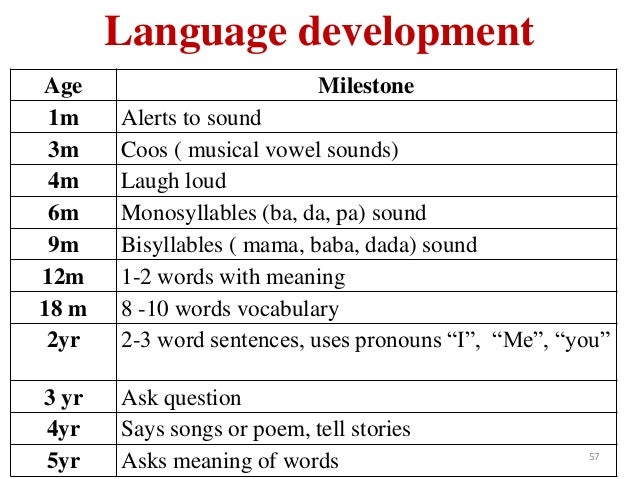Personal and Social Development
Personal and Social Development
- Beginning at around 1 month, the child intently watches his mother when she talks to him.

- He starts smiling back (social smile) when anyone talks to him or smiles at him by 6-8 weeks of age. It is important to differentiate social smile from spontaneous smile (smile without any social interaction), which is present even in neonates.
- By 3 months, he enjoys looking around and recognizes his mother.
- By 6 months, he vocalizes and smiles at his mirror image, and imitates acts such as cough or tongue protrusion.
- The child becomes anxious on meeting strangers (stranger anxiety) by 6-7 months of age.
- At this age he inhibits to "no". At 9 months, he waves "bye-bye" and also repeats any performance that evokes an appreciative response from the observers.
- By 1 year he can understand simple questions, such as "where is papa", "where is your ball", etc.
- By 15 months, he points to objects in which he is interested.
- By 18 months, he follows simple orders and indulges in domestic mimicry (imitates mother sweeping or cleaning).
- At 2 year when asked he can point to 5-6 familiar objects, name at least 2-3 objects and point to 3--4 body parts. He begins to count, identify 1-2 colors and sing simple rhymes by age of 3 year Much of these milestones depend on the caretaker's interaction and opportunities provided to the child.
- The left and right discrimination develops by 4 year by this age, play activities are also very imaginative.
- By 5 year of age, children can follow 3 step commands, identify four colors and repeat four digits.
| Age | Milestone |
| 2 Month | Social smile (smile after being talked to) |
| 3 Month | Recognizes mother; anticipates feeds |
| 6 Month | Recognizes strangers, stranger anxiety |
| 9 Month | Waves "bye bye" |
| 12 Month | Comes when called; plays simple ball game |
| 15 Month | Jargon(Infant babbling begins to resemble the native language of a child) |
| 18 Month | Copies parents in task (e.g. sweeping) |
| 2 Year | Asks for food, drink, toilet; pulls people to show toys |
| 3 Year | Shares toys; knows full name and gender |
| 4 Year | Plays cooperatively in a group; goes to toilet alone |
| 5 Year | Helps in household tasks, dresses and undresses |
Language-
- After appearance of social smile at around 6 to 8 weeks, the child begins to vocalize with vowel sounds such as 'ah, uh'.
- At 3-4 months, he squeals with delight and laughs loud. He begins to say 'ah-goo', 'gaga' by 5 months of age.
- By 6 months, he uses monosyllables (ba, da, pa). Later, he joins consonants to form bisyllables (mama, baba, dada). Before developing true meaningful speech,
- At around 9-10 months the child learns to imitate sounds derived from his native language.
- At his first birthday, he can usually say 1-2 words with meaning.
- At 18 months, he has a vocabulary of 8-10 words. Thereafter, the vocabulary increases rapidly to around 100 words by 2 year at which time 2-3 words are joined to form simple sentences.
- By 3 year the toddler continually asks questions and knows his full name. He can give a coherent account of recent experiences and events by the age of 4 year.

Vision -
- At birth, a baby can fixate and follow a moving person or dangling ring held 8-10 inches a way up to a range of 45°.
- This increases to 90° by 4 weeks and 180° by 12 weeks. At around 1 month, the baby can fixate on his mother as she talks to him.
- At about 3-4 months, the child fixates intently on an object shown to him (' grasping with the eye') as if the child wants to reach for the object. Binocular vision begins at around 6 weeks and is well established by 4 months.

- By 6 months, the child adjusts his position to follow objects of interest, can follow rapidly moving objects by 1 year Later the child displays more maturity in vision by not only identifying smaller objects but also being able to recognize them.
Hearing-
- Newborns respond to sounds by startle, blink, cry, quieting or change in ongoing activity.
- By 3 to 4 months, the child turns his head towards the source of sound. Hearing, may be checked by producing sound 1.5 feet away from the ear (out of field of vision), and a pattern of evolving maturity of hearing can be observed.
- At 5 to 6 months the child turns the head to one side and then downwards if a sound is made below the level of ears. One month later he is able to localize sounds made above the level of ears.
- By the age of 10 months the child directly looks at the source of sound diagonally